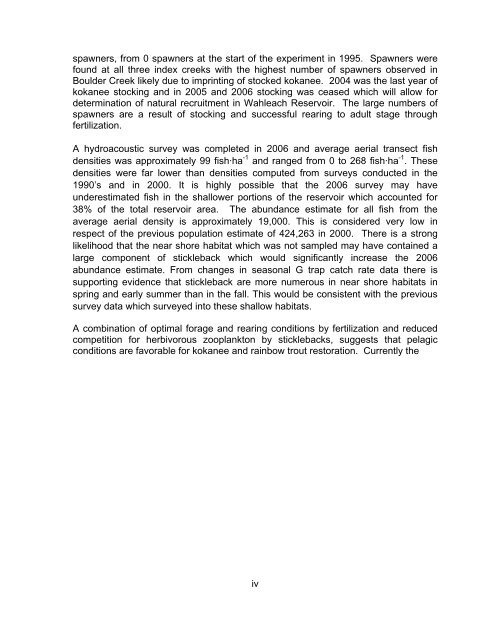Wahleach Project Water Use Plan Wahleach Reservoir ... - BC Hydro
Wahleach Project Water Use Plan Wahleach Reservoir ... - BC Hydro
Wahleach Project Water Use Plan Wahleach Reservoir ... - BC Hydro
You also want an ePaper? Increase the reach of your titles
YUMPU automatically turns print PDFs into web optimized ePapers that Google loves.
spawners, from 0 spawners at the start of the experiment in 1995. Spawners were<br />
found at all three index creeks with the highest number of spawners observed in<br />
Boulder Creek likely due to imprinting of stocked kokanee. 2004 was the last year of<br />
kokanee stocking and in 2005 and 2006 stocking was ceased which will allow for<br />
determination of natural recruitment in <strong>Wahleach</strong> <strong>Reservoir</strong>. The large numbers of<br />
spawners are a result of stocking and successful rearing to adult stage through<br />
fertilization.<br />
A hydroacoustic survey was completed in 2006 and average aerial transect fish<br />
densities was approximately 99 fish·ha -1 and ranged from 0 to 268 fish·ha -1 . These<br />
densities were far lower than densities computed from surveys conducted in the<br />
1990’s and in 2000. It is highly possible that the 2006 survey may have<br />
underestimated fish in the shallower portions of the reservoir which accounted for<br />
38% of the total reservoir area. The abundance estimate for all fish from the<br />
average aerial density is approximately 19,000. This is considered very low in<br />
respect of the previous population estimate of 424,263 in 2000. There is a strong<br />
likelihood that the near shore habitat which was not sampled may have contained a<br />
large component of stickleback which would significantly increase the 2006<br />
abundance estimate. From changes in seasonal G trap catch rate data there is<br />
supporting evidence that stickleback are more numerous in near shore habitats in<br />
spring and early summer than in the fall. This would be consistent with the previous<br />
survey data which surveyed into these shallow habitats.<br />
A combination of optimal forage and rearing conditions by fertilization and reduced<br />
competition for herbivorous zooplankton by sticklebacks, suggests that pelagic<br />
conditions are favorable for kokanee and rainbow trout restoration. Currently the<br />
iv
















